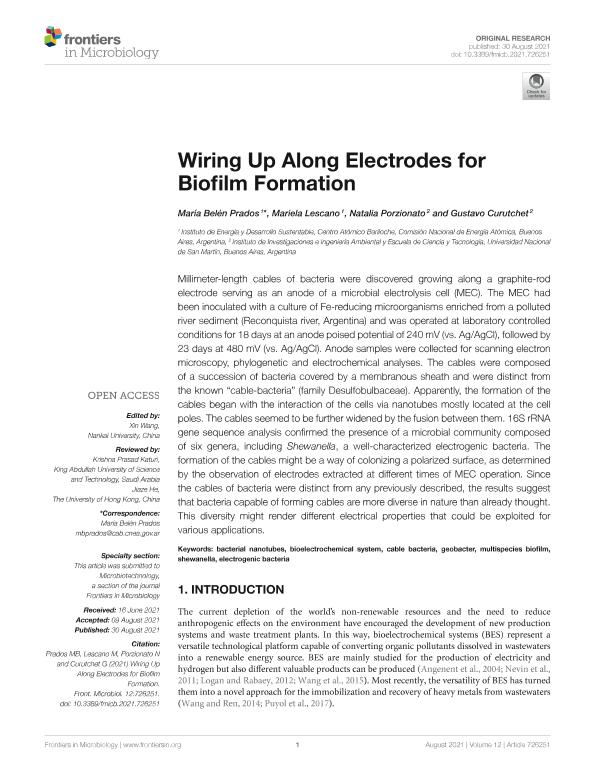Artículo
Wiring Up Along Electrodes for Biofilm Formation
Prados, Maria Belen ; Lescano, Mariela Ines; Porzionato, Natalia Florencia
; Lescano, Mariela Ines; Porzionato, Natalia Florencia ; Curutchet, Gustavo Andres
; Curutchet, Gustavo Andres
 ; Lescano, Mariela Ines; Porzionato, Natalia Florencia
; Lescano, Mariela Ines; Porzionato, Natalia Florencia ; Curutchet, Gustavo Andres
; Curutchet, Gustavo Andres
Fecha de publicación:
08/2021
Editorial:
Frontiers Media
Revista:
Frontiers in Microbiology
ISSN:
1664-302X
Idioma:
Inglés
Tipo de recurso:
Artículo publicado
Clasificación temática:
Resumen
Millimeter-length cables of bacteria were discovered growing along a graphite-rod electrode serving as an anode of a microbial electrolysis cell (MEC). The MEC had been inoculated with a culture of Fe-reducing microorganisms enriched from a polluted river sediment (Reconquista river, Argentina) and was operated at laboratory controlled conditions for 18 days at an anode poised potential of 240 mV (vs. Ag/AgCl), followed by 23 days at 480 mV (vs. Ag/AgCl). Anode samples were collected for scanning electron microscopy, phylogenetic and electrochemical analyses. The cables were composed of a succession of bacteria covered by a membranous sheath and were distinct from the known “cable-bacteria” (family Desulfobulbaceae). Apparently, the formation of the cables began with the interaction of the cells via nanotubes mostly located at the cell poles. The cables seemed to be further widened by the fusion between them. 16S rRNA gene sequence analysis confirmed the presence of a microbial community composed of six genera, including Shewanella, a well-characterized electrogenic bacteria. The formation of the cables might be a way of colonizing a polarized surface, as determined by the observation of electrodes extracted at different times of MEC operation. Since the cables of bacteria were distinct from any previously described, the results suggest that bacteria capable of forming cables are more diverse in nature than already thought. This diversity might render different electrical properties that could be exploited for various applications.
Archivos asociados
Licencia
Identificadores
Colecciones
Articulos(CCT - PATAGONIA NORTE)
Articulos de CTRO.CIENTIFICO TECNOL.CONICET - PATAGONIA NORTE
Articulos de CTRO.CIENTIFICO TECNOL.CONICET - PATAGONIA NORTE
Citación
Prados, Maria Belen; Lescano, Mariela Ines; Porzionato, Natalia Florencia; Curutchet, Gustavo Andres; Wiring Up Along Electrodes for Biofilm Formation; Frontiers Media; Frontiers in Microbiology; 12; 8-2021; 1-18
Compartir
Altmétricas



